
A golfer finishes a hole at Langston Golf Course, a historic 18-hole course in Washington, D.C., that’s part of the National Capital Parks-East complex. Photo courtesy of the U.S. National Park Service
Parks bring to mind turfgrass, picnics and games of catch. U.S. national parks, however, recall images of natural wonders and grand vistas — geysers in Yellowstone, Half Dome in Yosemite and the canyon in, well, the Grand Canyon.
National parks are found in 28 states and two U.S. territories, from the coral reefs and rainforests of American Samoa to Alaska’s glaciers, the coastal islands of Maine and the mangrove forests of the U.S. Virgin Islands.
Several national parks have significant turfgrass acreage in addition to their historical and natural features, and some of those parks and a few others also have an unexpected attraction — one or more golf courses.
The oldest course that is now in a U.S. national park first opened in 1892, but it only became part of a national park in August 1961, when President John F. Kennedy signed the Cape Cod National Seashore Act. Highland Links Golf Course in North Truro, Mass., is an authentic links course that overlooks the Atlantic Ocean and sits next to the first lighthouse on Cape Cod. Like other courses in national parks, Highland Links is on federal land but is managed by a private company.
To the south, in the Washington, D.C., area, the National Capital Parks-East comprises numerous parks and historical sites in the nation’s capital and the Maryland suburbs. Golf courses of historical interest are found in three of those parks.
Langston Golf Course, situated along the Anacostia River, opened in 1939 and was named for John Mercer Langston, the first black American elected to the U.S. Congress from Virginia. The course was built in response to a campaign from members of the black golfing community at a time when nearly all golf facilities were segregated.
A second course, the East Potomac Park Golf Course, which was built from 1918 to 1923, was part of efforts to desegregate public golf courses in Washington, D.C., in 1941. East Potomac Park is also home to one of the country’s oldest continuously operating miniature golf courses.
The third course in the National Capital Parks-East system, Rock Creek Golf Course in Washington, D.C., was opened by President Warren G. Harding in 1923. The National Park Service is studying all three of these courses and documenting their histories in order to understand their significance and make plans for their future use and preservation.
On the opposite side of the country, two California courses are also part of the National Park System. Built in 1895, Presidio Golf Club is now part of the 80,000-acre Golden Gate National Recreation Area. Once reserved for use by the military, Presidio GC was opened to the public in 1995. The course has been recognized for its commitment to environmentally sound management practices and is a Certified Audubon Cooperative Sanctuary.
The second West Coast course is the Big Trees Golf Club (named Wawona Golf Course when it opened in 1918) in Yosemite National Park. A nine-hole course that can be played as 18, Big Trees is also challenging because of its narrow fairways surrounded by scenic views and — you guessed it — big trees.
A final group of courses is in the heart of the country, in northeastern Ohio’s Cuyahoga (“crooked river”) Valley National Park. For many years, the park hosted four golf courses, but in May 2017, Cleveland Metroparks purchased Astorhurst Country Club and turned it into a naturalized area bordering the national park.
Three golf courses (all in Ohio) remain in the national park: Brandywine Country Club in Peninsula, Sleepy Hollow Golf Course in Brecksville, and Shawnee Hills Golf Course in Bedford.
Brandywine CC is a public par-3 course that is still owned by the family that built it. Sleepy Hollow and Shawnee Hills are managed by Cleveland Metroparks and are open to the public. Sleepy Hollow opened in 1924 as a private country club, but it became a public course in 1963 and has been named one of Golfweek’s top five courses in Ohio. Shawnee Hills boasts a par-3 course and an 18-hole course that switches from rolling terrain and water hazards to a wooded back nine.
For more information about turfgrass in U.S. national parks, see the National Park Service’s turf management page.
Teresa Carson is GCM’s science editor.